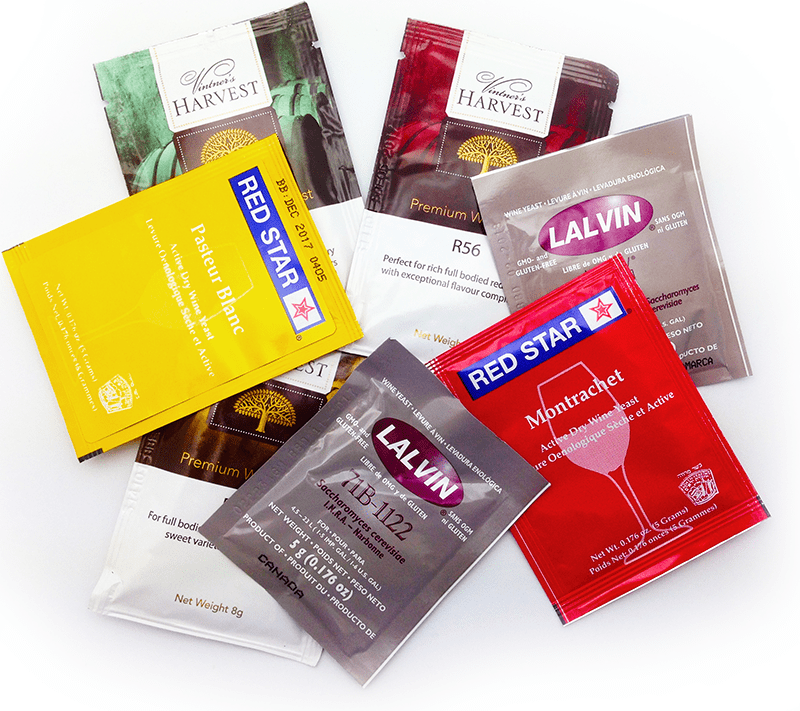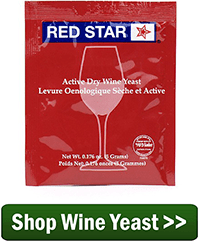 I have been making wine from fresh must purchased in 6 gallon pails I can not seem to get it as dry as commercial wines. It appears all sugars have fermented, SG.end up around 0.992-0.994. Is there a certain method or specific yeast to use? I have been using lavlin RC-212 for reds. Should I be choosing a different wine yeast?
I have been making wine from fresh must purchased in 6 gallon pails I can not seem to get it as dry as commercial wines. It appears all sugars have fermented, SG.end up around 0.992-0.994. Is there a certain method or specific yeast to use? I have been using lavlin RC-212 for reds. Should I be choosing a different wine yeast?
Name: Chuck H.
State: PA
—–
Hello Chuck,
This is a great question and one that has perplexed many winemakers. Choosing wine yeast is part of the art of wine making. What wine yeast you choose makes a difference.
When you ask the question: what type of wine yeast should I use? there is a lot to think about before answering. In fact, there is more to think about than most people realize, and this is where some home winemakers can fall just a little short in their wine making. Many are under the impression that wine yeast is just wine yeast and making a selection is not that big of deal. Sometimes the result can be pitching whatever yeast happens to be on hand. Some even contemplate adding bread yeast, but the wine yeast vs bread yeast thing is a whole other story.
In reality, there are many different wine yeast strains, each bringing its own to the wine. Some will ferment to higher levels of alcohol than others. This is called alcohol tolerance. Other wine yeast strains may not ferment to higher alcohol levels but are effective at fermenting down the residual sugars. This is referred to as wine yeast attenuation.
Different wine yeast types also have different flavor profiles. Some produce wines that are more rich and earthy while others produce wines that are more fresh and crisp. So it is important to understand that the wine yeast you select does make a difference and should be considered as one of the central ingredients of any wine recipe.
 In an effort to help the home winemaker that is faced with choosing wine yeast, we have developed a couple of wine yeast charts. One is for the Lalvin wine yeast chart. There are 5 different wine yeast strains listed on the Lalvin yeast chart. The other comparison chart is for the Vintner’s Harvest wine yeast chart. There are 9 different wine yeast strains listed on Vintner’s Harvest wine yeast chart.
In an effort to help the home winemaker that is faced with choosing wine yeast, we have developed a couple of wine yeast charts. One is for the Lalvin wine yeast chart. There are 5 different wine yeast strains listed on the Lalvin yeast chart. The other comparison chart is for the Vintner’s Harvest wine yeast chart. There are 9 different wine yeast strains listed on Vintner’s Harvest wine yeast chart.
Chuck, when looking at the profile chart for the Lalvin wine yeast you can see that the RC 212 wine yeast that you used has a moderate fermentation speed and a good alcohol tolerance, but yet it is not producing a wine that is dry enough for your tastes. For this reason I would suggest trying the Lalvin EC 1118 next time. Generally, it is a harder fermenter than the RC 212 and should get you closer to what you are looking for.
If you are interested you can also take a look at the Vintner’s Harvest wine yeast chart and see if anything there is of interest to you. This comparison chart has a little more detail in terms of yeast flavor profiles.
As a side note: while the wine yeast strain you select will make a difference in the outcome of your wine, the fermentation environment plays a role as well. The temperature of the fermentation; the amount of nutrients and the amount of oxygen all effect how complete the wine will ferment. In other words, the yeast need to be happy. Everything mentioned in this blog post about choosing wine yeast is based on the premise that things are in place to produce a normal, healthy fermentation.
So as you can see there is are differences in wine yeasts. I urge you to use this to your advantage and take control of the flavors the wine yeast are adding to your wines by always knowing what type of wine yeast you should be using to achieve the character and flavors you are looking for. Make choosing wine yeast a conscious decision.

The perception of "dryness" in a wine is not simply the opposite of "sweet" – it is more the effect of tannins/acids and other characteristics that the pallet interprets as "dry". Since Chuck’s fermentations appear to be complete with no residual sugars, I would think a more specific solution would be to address tannins and acid levels. Great notes on the yeast varieties.
Possibly Chuck could use a different must of whole cluster red/black grapes using skins and the stems in the brew for a more tannin heavy ferment.
I’m planning on using Fosch & Brianna grapes this year. Your wine yeast charts don’t list these grapes. What is your recommendations for yeast on these two?
Graham, there are literally hundreds of wine grape varieties. It would be impossible for a chart to have yeast recommendations for each one. However, by looking at the varieties that are listed on the chart you can get an idea of what would work well with the grapes you have. Foch is most similar to Gamay on the chart and Brianna is most similar to Muscat. This should help you to make a selection.
Vintner’s Harvest Yeast Profiles
http://www.eckraus.com/VintnersHarvestProfiles.htm
Ron, here are two links that will take you to the yeast profile charts:
Lalvin Yeast Profile Chart
http://www.eckraus.com/LalvinProfiles.htm
Vintner’s Harvest Yeast Profile Chart
http://www.eckraus.com/VintnersHarvestProfiles.htm
Where can I find this chart? I would like to try different strains of yeast.
Thanks, Ron
Ed –
Doesn’t changing yeast cultures require a change in the amount of total sugars in the recipe? Do you prefer to start by allowing the must to cool to a certain temperature, taking a specific gravity, then adding water until a pre-determined specific gravity is achieved, then adding the yeast?
Kilocharlie, the wine yeast selected and the amount of sugar needed are not related. Regardless of the wine yeast you select, you want to either added sugar according to a recipe being followed, or as you suggested, by targeting a beginning specific gravity reading with a hydrometer.
I have 30 pounds of Maine blueberries and 30 pounds of cherries. Most recipes call for 11-18 pounds for a 5 or 6 gallon batch. Can I use 30 pounds instead and make a stronger batch of each kind of wine? If so, do need to adjust any of the other ingredients?
Marshall, you can possibly add more fruit to a wine recipe. Your main limitation is acidity. For example, you can add so much blueberry that the wine is too tart to drink. Even if you don’t add too much fruit, you will definitely need to reduce the amount of any acid blend called for. The amount of sugar will also need to be adjusted down to compensate for the additional sugars added by the additional fruit. Yeast, pectic enzyme and yeast nutrient will all remain the same. Tannin is not to critical. If you are adding 50% more fruit or higher, I would not add any tannin at all. There will be plenty coming from the fruit. The logical way to handle this is to crush all the fruit and add water to a total volume of about 4.75. Then take an acid test kit to determine how much acid blend you need to add. If your acid is already over the normal range you may need to dilute with more water. The acid test kit will tell you what range you are looking for in the directions. Once you have the acid correct, you can add sugar according to your hydrometer. You are best off adding the sugar as a syrup. This syrup can be made by heating equal parts of water and sugar until it become clear. Stir continuously so that the sugar does not burn. Use the "potential alcohol" scale on the hydrometer. Add sugar until it reads between 11% and 13%. Be sure the sugar syrup is evenly blended before taking any hydrometer readings. Sometimes it likes to hang at the bottom of the fermenter. Now that the acidity and sugar is set, you can move on to adding the other ingredients, and making the wine as you normally would.
Acid Test Kit
http://www.eckraus.com/acid-test-kit.html
Hydrometer
http://www.eckraus.com/triple-scale-hydrometer.html
Do you have a chart like this for Red Star wine yeast?
Kent, actually we do have a yeast chart for the Red Star Yeast. The link is listed below.
Red Star Yeast Profile Chart
http://www.eckraus.com/RedStarProfiles.htm
Neither chart lists attenuation properties, is there any info. available on this?
Michael,I am sorry, we do not have the attenuation information available. However I would imagine that if you search the internet, it is out there somewhere.
What would be the difference between the two yeast of Champagne yeast and EC-1118 when making Mead Wine. What would the difference in flavor would Champagne yeast impart over EC1118, EC1118 may bring the wine to a dryer state but what flavor would it impart over Champagne yeast.
Robert, flavor wise you probably would not notice any difference between the 2 yeasts. Both yeasts have a high alcohol tolerance and should ferment to dryness.
Here is a interesting one if you want to work a wine yeast all the way out with out killing it with sorbate, to say 13 to 15 percent what would be the best yeast for say a red wine. I am making a sweet wine I done this many years ago i think i used red star. thanks for any info.
Eddie, in the Red Star brand the types with the highest alcohol content are the Premier Cuvee and the Premier Blanc.
I don’t understand your “x” ratings on the charts. What is the difference between “x” and “xxxx”?
The more “X”‘s the better the yeast is suited for that purpose.
Ed what yeast would you recommend for making a dessert wine out of plums, watermelon, scuppernog grapes? Thank you for your input!
Randal, I would probably use the Vintner’s Harvest CY17 yeast for dessert wine.
Vintner’s Harvest Yeast
https://eckraus.com/vintners-harvest-premium-wine-yeast/
I had delicious muscadine wine that was very powerful but was so delicious. You could barely taste the alcohol. An old man I worked with made it. He was super country. I am sure he has passed away now but that has stuck with me for decades. I really wish I could capture this. It was amazing. Amazon wasn’t around then and I can’t imagine this guy had access to special yeast. It had been made about 7 months before we drank it. We were all lit. We had a wonderful visit with him and his family.
Hello! Thank you for this post, Ed. I am making Dolcetto for the first time this year, and am trying to decide on my yeasts. This is a low acid, high tannin varietal. I would like to bring out as much complexity as I can … keeping it dry and not overly fruity.